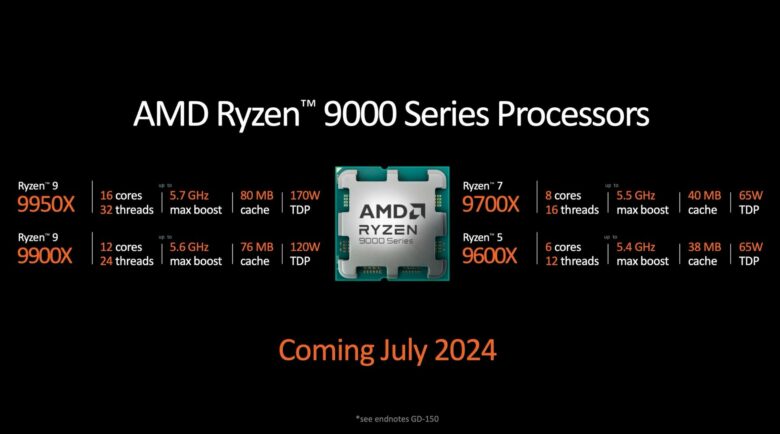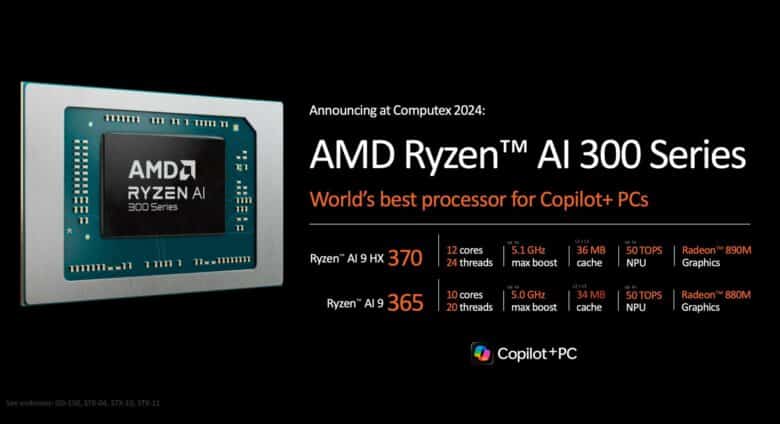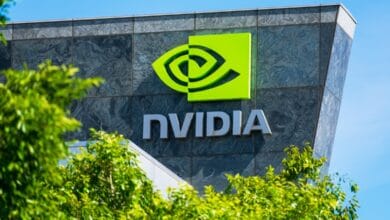
Chip manufacturer AMD let the cat out of the bag at the current Computex 2024: In addition to the new “fastest desktop processors in the world”, the AMD Ryzen 9000 series, new notebook CPUs were also presented with the AMD Ryzen AI 300 series.
AMD Ryzen 9000 series with Zen 5
Let’s start with “Granite Ridge”, the name of the AMD Ryzen 9000 series, which will power desktop PCs in the future and which, according to the manufacturer, are the fastest desktop CPUs in the world.
The processors are based on the Zen 5 architecture, but remain true to the previous AM5 socket, although there will be new chipsets in the 800 series. The top model is called the AMD Ryzen 9 9950X and, with 16 cores, 32 threads, a boost clock of up to 5.7 GHZ and 170 watts TDP, is set to take on the Intel Core i9-14900K, which AMD claims will outperform it in terms of gaming and productivity.

This will be joined by three further models for release in July 2024. Specifically, the line-up for the launch is as follows:
| Chip | Cores | Threads | Boost clock | Cache | TDP |
|---|---|---|---|---|---|
| AMD Ryzen 9 9950X | 16 | 32 | 5.7 GHz | 80 MB | 170W |
| AMD Ryzen 9 9900X | 12 | 24 | 5.6 GHz | 76 MB | 120W |
| AMD Ryzen 7 9700X | 8 | 16 | 5.5 GHz | 40 MB | 65W |
| AMD Ryzen 5 9600X | 6 | 12 | 5.4 GHz | 38 MB | 65W |
Initial benchmark results from AMD should allow 56 percent more performance in Blender and 21 percent higher values in Cinebench in direct comparison to the Core i9-14900K. In the gaming sector, the increase in performance is said to be between 4 percent (Borderlands 3) and 23 percent (Horizon Zero Dawn), depending on the game.
The new Zen 5 architecture has a significant influence on the leap in performance and is said to deliver an average of 16% more performance than Zen 4 at the same clock rates.

Also new are the X870 and X870E chipsets, which are launching at the same time. AMD has not yet provided any specific details, but USB4 will become standard on all motherboards, while both graphics cards and an NVMe SSD can be connected via PCIe 5.0.
AMD Ryzen AI 300 series for notebooks
For notebook CPUs, however, AMD is following a completely new naming scheme. Presumably to achieve a better differentiation from the desktop processors, but also from Intel’s Core Ultra series.
AMD Ryzen AI 300 is the name of the series that will be used from the upcoming notebook CPUs onwards. Ryzen AI indicates that the chips are equipped with a fast NPU. This is followed by a number such as 7 or 9, which still stands for the class of the chip.
The combinations U, HS and HX continue to stand for the product class or TDP, while a three-digit number behind it, such as 370, stands for the processor series and SKU. The 3 denotes the 3rd generation of AI-supported Ryzen chips, after Ryzen 7000 and Ryzen 8000 already had an AI accelerator.
In concrete terms, the chips will therefore be called AMD Ryzen AI 9 HX 370, for example, which marks the upcoming top model in the series.

The AMD Ryzen AI 9 HX 370 and the AMD Ryzen AI 9 365 have so far been officially confirmed and presented. They differ from each other in their design and performance and both also rely on a Zen 5 architecture:
- The AMD Ryzen AI 9 HX 370 comes with 12 cores, 24 threads, 5.1 GHz boost clock, 36 MB cache, 50 TOPS NPU and Radeon 890M iGPU (16 CUs)
- The AMD Ryzen AI 9 365 has 10 cores, 20 threads, 5.0 GHz boost, 34 MB cache, 50 TOPS NPU and Radeon 890M iGPU (12 CUs)

The focus is once again on the Neural Processing Unit (NPU), which should work twice as efficiently as its predecessor thanks to the new XDNA 2 architecture. This should achieve 50 TOPS of performance, which would make the AI performance even better than that of the Qualcomm Snapdragon X Elite.
The new Radeon 890M iGPU has also made significant gains, not least thanks to the new RDNA 3.5 architecture and up to 16 compute units. Compared to the Radeon 780M, this should enable 33 percent more performance.
The CPU benchmarks published by AMD to date show that the Ryzen AI 9 HX 370 is up to 47 percent faster in gaming than Intel’s Core Ultra 9 185H. The lead in Cinebench 24 is also 47 percent.

Apple’s M3 chip is even said to be outperformed by 70 percent in Cinebench’s multi-thread benchmark, while the Qualcomm Snapdragon X Elite is beaten by 30 percent. So it all sounds very promising, but should of course be taken with a grain of salt.



